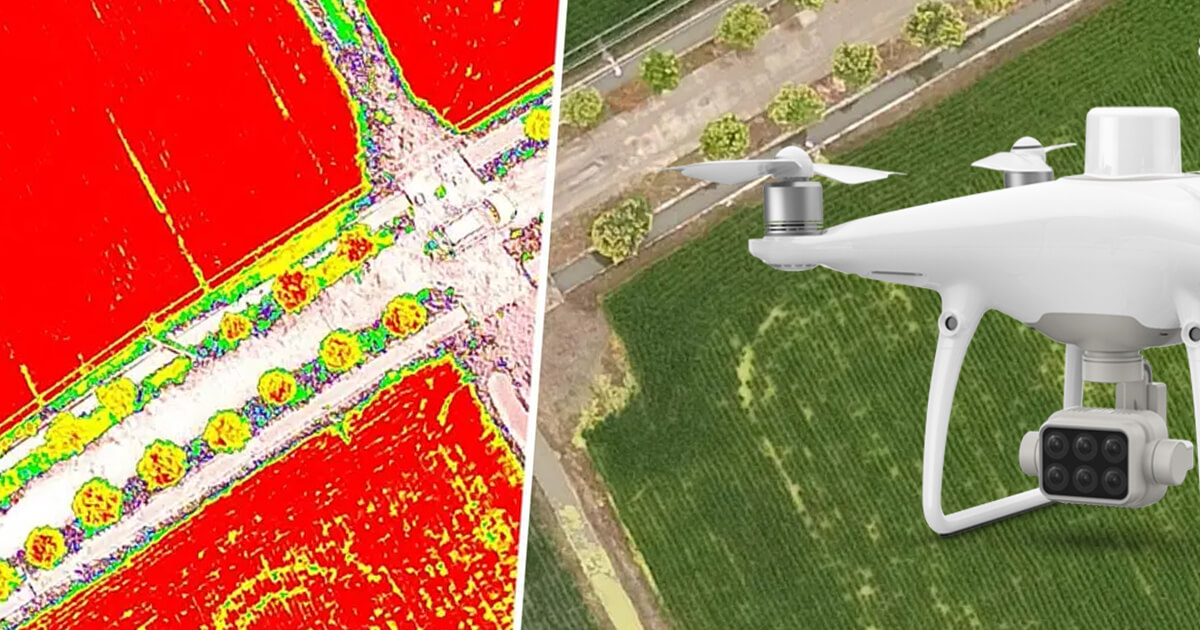Not only do many OEMs provide machines to both sectors (John Deere, CNHI and JCB), but agriculture, just like construction, is not famous for digitalization. However, we must admit that agriculture is nowadays a few steps ahead of us in the race for innovation. That is the reason why we will be taking a closer look at how they are utilizing drone (UAV) technology and discover what we can learn from them.
A quick review of drone use in construction
Drone technology has drastically revolutionized the ways of working in construction as well as in sectors such as mining, roofing, oil, and gas, etc. The productivity gains by capturing a top-down view are massive.
In construction, we mainly use drones to tackle two challenges: inspection of existing buildings and terrain measurement. Inspection is all about taking thousands of pictures of a building – a bridge, for example – and studying them to find defects such as signs of cracking. Terrain measuring with drones makes use of the collected images to create a 3D model. Based on this model, you can directly measure distance and elevation, perform cut-and-fill analysis, visualize your work progress, and compare it with your design.
Drone and precision farming
In agriculture, drone technology is an essential player in the so-called precision farming system. Precision farming is a method used by farmers to manage their planting and achieve the maximum amount of crop. To summarize in a few words, it’s about using digital technology to gain an in-depth understanding of the field and, based on this information, maximizing the efficiency of all resources such as water, fertilizers, and pesticides.
In this process, drone technology is mainly applied for two tasks: field inspection and spraying.
Field inspection with multispectral data
During field inspection, farmers send out drones to collect aerial imaginaries. What is special about these drones is that they are equipped with multispectral cameras. Multispectral cameras are very good at field inspection because they can capture features of plants that we can’t see with bare eyes. Simply explained, healthy plants reflect an amount of near-infrared (NIR) light that is invisible to human eyes. It means that we can’t conclude that a green leaf is healthy by simply observing it. Only the near-infrared light can allow us to draw such conclusions. While human eyes can’t capture this type of light, multispectral cameras can identify it by recognizing its unique wavelength.

Once multispectral data are collected, people can further interpret them and understand the condition of their plants using different analytical frameworks and models. For example, if we process multispectral data with the Normalized Difference Vegetation Index (NDVI), we can then estimate the drought conditions on an area of land.

Treatment delivery
Having identified the regions where extra care is needed, farmers can send out tank-equipped octocopters – these are powerful drones with eight propellers – to spray water and agrochemicals on these specific spots.
In the farming sector, people are already enjoying some significant benefits thanks to precision farming. A report shows that precision farming systems can help farmers increase harvest by 10-15%, and this is a satisfying amount for an industry where slim profit margins are the norm.

More complexity in construction
Having compared both sectors, we can see that in construction, the benefits brought by drone technology are still limited to measurement and inspection. Why this contrast?
Each project is unique
First, each jobsite is understood as unique, whereas crop fields usually do not move beyond a certain geographical region and work is relatively repeatable year after year. This characteristic makes the amount of crop and cost per unit easy to compare and benchmark.
Farming is quite similar to a production process where productivity is well understood – very much like manufacturing. So, once innovative technologies are implemented, people can quickly appreciate the return of investment.
By contrast, in construction, the lack of an industry standard or historical productivity figures of the particular jobsite makes the contribution of drone technology to productivity more difficult to assess.
Change in process
Furthermore, drone technology is well integrated in the whole precision farming process. As we’ve seen, drones are not only used to inspect the condition of fields but also to deliver treatment. However, drone technology is still limited to parts of the construction project cycles. One reason might be that, in construction, tasks are usually performed by different teams using different technologies. This implies that another major challenge is to bring all parties active on the jobsite along on the journey towards digital transformation.
Flying drones is only the beginning
Due to the nature of construction projects, these complexities are not always avoidable. But this should not discourage us. We can’t deny that every project has its unique characteristics, but let’s keep in mind that many of the operations on the jobsite are repeatable and that we can indeed make sense of them. It only requires a smarter way of managing data and extracting information out of them. Fortunately, a lot of solutions already exist to achieve this goal.
At Smart Construction, we believe that a full digital transformation throughout the entire project cycle can make a real change to the complexities. That’s why we are here to accompany our clients on their way towards a successful digitalization of their workflow. From bidding to reporting, Smart Construction offers our clients the right digital solutions, individual consultancy service and hands-on guidance. Flying drones is a good beginning, but it’s only part of the efforts we need to make together to catch up with other industries in the innovation race.
